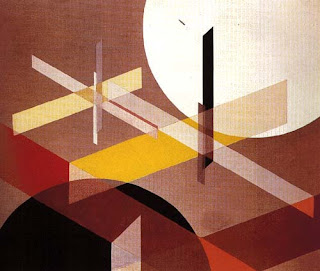I Just came across a book of Moholy Nagy in my office library today. It brought back a memory of what I was going through in University of East London. I only realised sometime later that the methodology of teaching was adopted literary from Bauhaus which was already then 80 years old. Still today, we can see some artists going though similar thinking process as those days, but done with more contemporary manner. Moholy Nagy's has always been one of my idols with his transcendence work with objects, images and paintings. His photogram through the transformation of the object into an obscuring image makes an interesting representation of a condition in between material and the image. I feel its so mythological. One day, I would like to make an image that represents my mythological counterpart.
 "Composition Z VIII" (1924)
"Composition Z VIII" (1924)To achieve the illusion of space, in these work an objects altering from foregrounded, background, translucent to opaque, light to dark. Moholy-Nagy stated, "Tearing apart the old visual conception, the cubist painters originated a new means of rendering, as well as a space articulation.
 "Construction" (1932)
"Construction" (1932) Not only a depth of space, but movement, floating without sense of gravity. He expressed in 'vision in motion, floating objects in space, no longer grounded, but achieving a new harmony in a state of equilibrium. Eventually Moholy-Nagy saw the limitation inherent in pigment on canvas and worked towards the use of light as a means of achieving new imagery and qualities of abstraction. Moholy-Nagy began working with light-sensitive technique, the photogram. Exposing light to light sensitive paper revealing a translucent shape: literally "painting with light.


 Black, White, Grey" (1932)
Black, White, Grey" (1932)
No comments:
Post a Comment